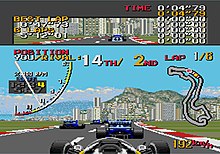
Columns is a match-three puzzle video game released by Sega in 1990. Designed by Jay Geertsen, it was released by Sega for arcades and then ported to several Sega consoles. The game was subsequently ported to home computer platforms, including the Atari ST.
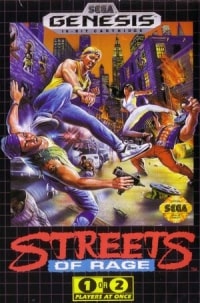
Streets of Rage is a beat 'em up game developed and published by Sega for the Genesis in 1991. Players control one of three former police officers turned vigilantes who battle a crime syndicate. Streets of Rage establishes many conventions of the Streets of Rage series, such as two-player cooperative play and an acclaimed techno soundtrack from composer Yuzo Koshiro. It was ported for the Game Gear, Sega CD and Master System and has been rereleased as part of various compilations and on download services.

Virtua Racing or V.R. for short, is a Formula One racing video game developed by Sega AM2 and released for arcades in 1992. Virtua Racing was initially a proof-of-concept application for exercising a new 3D graphics platform under development, the "Model 1". The results were so encouraging that Virtua Racing was fully developed into a standalone arcade title.

Sega Classics Arcade Collection is the name of two compilations released for the Sega CD. Despite their titles, both versions of Sega Classics Arcade Collection include only the Sega Genesis ports of all the games included.
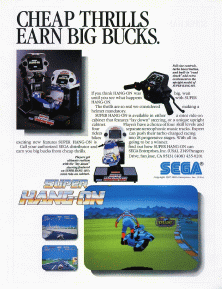
Super Hang-On is a motorcycle racing arcade video game released by Sega as the sequel to Hang-On. It uses a simulated motorcycle arcade cabinet, like the original game. An updated version was released in arcades 1991 as Limited Edition Hang-On.

The Sega Genesis, also known as the Mega Drive outside North America, is a 16-bit fourth generation home video game console developed and sold by Sega. It was Sega's third console and the successor to the Master System. Sega released it in 1988 in Japan as the Mega Drive, and in 1989 in North America as the Genesis. In 1990, it was distributed as the Mega Drive by Virgin Mastertronic in Europe, Ozisoft in Australasia, and Tectoy in Brazil. In South Korea, it was distributed by Samsung Electronics as the Super Gam*Boy and later the Super Aladdin Boy.

Formula One World Championship: Beyond the Limit, released in Japan as Heavenly Symphony: Formula One World Championship 1993 (ヘブンリーシンフォニー) is a racing game developed and published by Sega, with production assistance from by Fuji Television, and released for the Sega CD in 1994. As the name implies, the game places the player in the seat of a Formula One car complete with multiple teams and opponents, and all the licensed tracks of the series.
Tec Toy S.A., trading as Tectoy since late 2007, is a Brazilian toy and electronics company headquartered in São Paulo. It is best known for producing, publishing, and distributing Sega consoles and video games in Brazil. The company was founded by Daniel Dazcal, Leo Kryss, and Abe Kryss in 1987 because Dazcal saw an opportunity to develop a market for electronic toys and video games, product categories that competitors did not sell in Brazil at the time. The company stock is traded on the Bovespa.

F1 is a 1993 racing video game published by Domark, based on Vroom, a game developed in 1991 for the Atari ST by French company Lankhor. It was released for the Mega Drive/Genesis, Master System, Game Gear, and Amiga.

Super Monaco GP is a Formula One racing simulation video game released by Sega, originally as a Sega X Board arcade game in 1989, followed by ports for multiple video game consoles and home computers in the early 1990s. It is the sequel to the 1979 arcade game Monaco GP. The arcade game consists of one race, the Monaco Grand Prix, but later ports added more courses and game modes based on the 1989 Formula One World Championship.

Tommy Lasorda Baseball is a 1989 baseball video game developed and published by Sega as one of the six launch titles for the Sega Genesis in the North America and for the Sega Mega-Tech arcade system. It is a follow-up to the arcade game Super League (1987). It prominently features former MLB player Tommy Lasorda, who was manager of the Los Angeles Dodgers at the time. In the game, players compete with either AI-controlled opponents or against other players across single exhibitions, open matches or a 30-game season.

Fever Pitch Soccer, known as Head-On Soccer in North America, is a soccer video game originally developed and published by U.S. Gold for the Sega Genesis/Mega Drive in 1995.
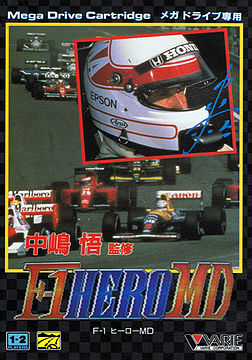
Nakajima Satoru Kanshuu F1 Hero MD is a Formula One video game endorsed by Satoru Nakajima that was released in 1992 for the Mega Drive/Genesis, Nintendo Entertainment System, and Nintendo Game Boy. The North American and European versions of the game are known as Ferrari Grand Prix Challenge in reference to Ferrari, specifically their Formula One team.

Fastest 1 (ファステスト・ワン) is a Sega Mega Drive racing game video game released in 1991 exclusively in Japan. During the release of this video game, other Formula One video games like Super Monaco GP had caused a general increase of demand for Formula One video games. While most of those games were poor simulations of the races, Fastest One proved to be the most realistic of the era.

Monaco GP is an arcade racing game released by Sega in November 1979 in Japan, and January 1980 worldwide. An upgraded version, Pro Monaco GP, was released later in 1980. One of the last Sega games to use TTL chips instead of a microprocessor CPU, the game has players race against a clock and pass rival racers while attempting to earn points driving through five areas.
Ever since Pole Position in 1982, Formula One (F1) has always played a part of the racing genre in video games. Early Formula One games were typically arcade racing games, before Formula One Grand Prix (1991) popularized Formula One racing simulations on home computers.

Nakajima Satoru Kanshuu F1 Grand Prix is a 1991 Sega Mega Drive Formula One video game based on the career of Satoru Nakajima. Nakajima was the first full-time Japanese racer in the history of Formula One. In fact, this was the first game that Nakajima endorsed for a Japanese video gaming system. The entire 1991 Formula One season can be re-enacted with any of the notable contenders from the prestigious Formula One racing organization.

F1 Pole Position is a 1992 racing video game for the SNES, developed by Human Entertainment and published by them in Japan, while the other versions were handled by Ubisoft. It is the first game in the Human Grand Prix/F1 Pole Position series, which features Formula One licensing.
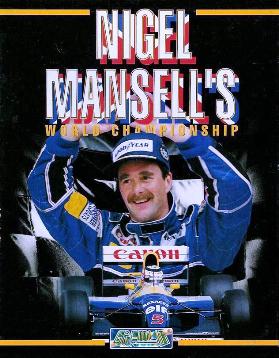
Nigel Mansell's World Championship Racing is an arcade-style Formula One racing video game developed by Gremlin Graphics and released for various systems. The game was largely successful on Amiga and DOS platforms, and was consequently ported to home consoles.

Satoru Nakajima F-1 Hero GB World Championship '91 is a 1991 Japan-exclusive Game Boy Formula One video game published by Varie, endorsed by Satoru Nakajima, who was the first full-time Japanese racer in the history of Formula One. Apart from Nakajima, the actual names of the drivers are not used due to licensing arrangements.


